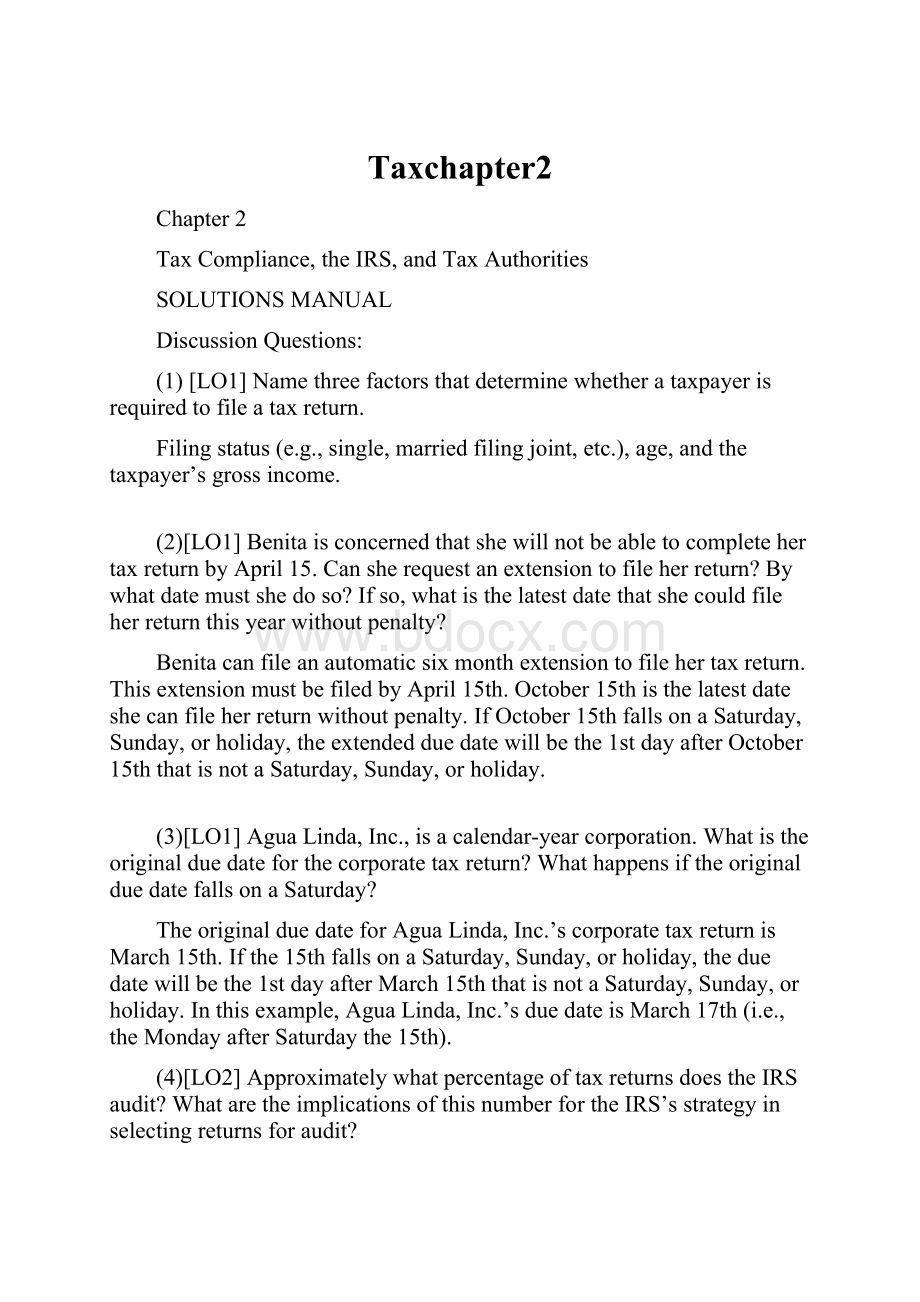Taxchapter2.docx
《Taxchapter2.docx》由会员分享,可在线阅读,更多相关《Taxchapter2.docx(24页珍藏版)》请在冰豆网上搜索。

Taxchapter2
Chapter2
TaxCompliance,theIRS,andTaxAuthorities
SOLUTIONSMANUAL
DiscussionQuestions:
(1)[LO1]Namethreefactorsthatdeterminewhetherataxpayerisrequiredtofileataxreturn.
Filingstatus(e.g.,single,marriedfilingjoint,etc.),age,andthetaxpayer’sgrossincome.
(2)[LO1]BenitaisconcernedthatshewillnotbeabletocompletehertaxreturnbyApril15.Cansherequestanextensiontofileherreturn?
Bywhatdatemustshedoso?
Ifso,whatisthelatestdatethatshecouldfileherreturnthisyearwithoutpenalty?
Benitacanfileanautomaticsixmonthextensiontofilehertaxreturn.ThisextensionmustbefiledbyApril15th.October15thisthelatestdateshecanfileherreturnwithoutpenalty.IfOctober15thfallsonaSaturday,Sunday,orholiday,theextendedduedatewillbethe1stdayafterOctober15ththatisnotaSaturday,Sunday,orholiday.
(3)[LO1]AguaLinda,Inc.,isacalendar-yearcorporation.Whatistheoriginalduedateforthecorporatetaxreturn?
WhathappensiftheoriginalduedatefallsonaSaturday?
TheoriginalduedateforAguaLinda,Inc.’scorporatetaxreturnisMarch15th.Ifthe15thfallsonaSaturday,Sunday,orholiday,theduedatewillbethe1stdayafterMarch15ththatisnotaSaturday,Sunday,orholiday.Inthisexample,AguaLinda,Inc.’sduedateisMarch17th(i.e.,theMondayafterSaturdaythe15th).
(4)[LO2]ApproximatelywhatpercentageoftaxreturnsdoestheIRSaudit?
WhataretheimplicationsofthisnumberfortheIRS’sstrategyinselectingreturnsforaudit?
Currently,lessthan2percentofalltaxreturnsareaudited.TheIRSmustbestrategicinselectingreturnsforauditinanefforttopromotethehighestlevelofvoluntarytaxpayercompliance.
(5)[LO2]ExplainthedifferencebetweentheDIFsystemandtheNationalResearchProgram?
Howdotheyrelatetoeachother?
(6)
TheDIFsystemisbasicallyascoringsystemthatassignsascoretoeachtaxreturnthatrepresentstheprobabilitythatthetaxliabilityonthereturnhasbeenunderreported(i.e.,ahigherscore,ahigherlikelihoodofunderreporting).TheIRSderivestheweightsassignedtospecifictaxreturnattributesfromhistoricalIRSauditadjustmentdatafromtheNationalResearchProgram(NRP).
TheNRPanalyzesrandomlyselectedreturnstoensurethattheDIFscoringsarerepresentativeofthepopulationoftaxreturns.TheDIFsystemthenusesthese(undisclosed)weightstoscoreeachtaxreturnbasedonthetaxreturn’scharacteristics.ReturnswithhigherDIFscoresarethenreviewedtodetermineifanauditisthebestcourseofaction.
(7)[LO2]Describethedifferencesbetweenthethreetypesofauditsintermsoftheirscopeandtaxpayertype.
ThethreetypesofIRSauditsconsistofcorrespondence,office,andfieldexaminations.Correspondenceexaminationsarethemostcommon.Theseaudits(asthenamesuggests)areconductedbymailandgenerallyarelimitedtooneortwoitemsonthetaxpayer’sreturn.Amongthethreetypesofaudits,correspondenceauditsaregenerallythemostnarrowinscopeandleastcomplex.
Officeexaminationsarethesecondmostcommonaudit.Asthenamesuggests,theIRSconductstheseauditsatthelocalIRSoffice.Theseauditsaretypicallybroaderinscopeandmorecomplexthancorrespondenceexaminations.Smallbusinesses,taxpayersoperatingsoleproprietorships,andmiddletohigh-incomeindividualtaxpayersarelikelycandidatesforofficeexaminations.Intheseexaminations,thetaxpayerreceivesanoticethatidentifiestheitemssubjecttoaudit,requestssubstantiationfortheseitemsasnecessary,andnotifiesthetaxpayerofthedate,time,andlocationoftheexam.Taxpayersmayattendtheexaminationaloneorwithrepresentation(e.g.,taxadviser,attorney,etc.).
Fieldexaminationsaretheleastcommonaudit.TheIRSconductstheseauditsatthetaxpayer’soffice(i.e.,placeofbusiness),orthelocationwherethetaxpayer’sbooks,recordsandsourcedocumentsaremaintained.Fieldexaminationsaregenerallythebroadestinscopeandmostcomplexofthethreeaudittypes.Theycanlastmanymonthstomultipleyearsandgenerallyarelimitedtobusinessreturnsandthemostcomplexindividualreturns.
(8)[LO2]Simonjustreceiveda30-dayletterfromtheIRSindicatingaproposedassessment.Doeshehavetopaytheadditionaltax?
Whatarehisoptions?
Simondoesnothavetopaytheadditionaltaxatthistime.The30-dayletter
instructsthetaxpayerthatheorshehas30days
(1)torequestaconferencewithanappealsofficer,whoisindependent(residesinaseparateIRSdivision)fromtheexaminingagentor
(2)toagreetotheproposedadjustment.IfthetaxpayerchoosestogototheappealsconferenceandreachesanagreementwiththeIRSattheappealsconference,thetaxpayercanthensigntheForm870.IfthetaxpayerandIRSdonotagreeontheproposedadjustmentattheappealsconference,orthetaxpayerchoosesnottorequestanappealsconference,theIRSwillthensendthetaxpayera90-dayletter(statutorynoticeofdeficiency).
(9)[LO2]Compareandcontrastthethreetrial-levelcourts.
TheU.S.DistrictCourtistheonlycourtthatprovidesforajurytrial;theU.S.TaxCourtistheonlycourtthatallowstaxcasestobeheardbeforethetaxpayerpaysthedisputedliabilityandtheonlycourtwithasmallclaimsdivision(hearingclaimsinvolvingdisputedliabilitiesof$50,000orless);theU.S.TaxCourtjudgesaretaxexperts,whereastheU.S.DistrictCourtandU.S.CourtofFederalClaimsjudgesaregeneralists.BoththeU.S.TaxCourtandlocalU.S.DistrictCourtcasesappealtothespecificcircuitcourtbasedonthetaxpayer’sresidence.Incontrast,allU.S.CourtofFederalClaimscasesappealtotheU.S.CircuitCourtofAppealsfortheFederalCircuit.
(10)[LO3]Compareandcontrastthethreetypesoftaxlawsourcesandgiveexamplesofeach.
ThethreetypesoftaxlawsourcesincludestatutoryauthorityissuedbyCongress(e.g.,theInternalRevenueCode,committeereports),judicialauthority(i.e.,rulingsbytheU.S.DistrictCourt,U.S.TaxCourt,U.S.CourtofFederalClaims,U.S.CircuitCourtofAppeals,orU.S.SupremeCourt),andadministrativeauthority(e.g.,regulations,revenuerulings,andrevenueprocedures).Inadditiontobeingissuedbydifferentgroups,theformatandpurposesofeachoftheseauthoritiesaredifferent.WhereasstatutoryauthoritiesaretaxlawsenactedbyCongress,judicialandadministrativeauthoritiesgenerallyinterpretenactedtaxlaws.
(11)[LO3]TheConstitutionisthehighesttaxauthoritybutprovidesverylittleinthewayoftaxlaws.WhatarethenexthighesttaxauthoritiesbeneaththeU.S.Constitution?
TheInternalRevenueCodeof1986andSupremeCourtdecisionsrepresentthehighesttaxauthoritybeneaththeU.S.Constitution.However,theSupremeCourtdoesnotestablishlaw,butinstead,simplyinterpretsandappliestheCode(andotherauthorities).
(12)[LO3]JackiehasjustopenedherCodeforthefirsttime.ShelooksatthetableofcontentsandwonderswhytheCodeisorganizedthewayitis.Shequestions
whetheritmakessensetotryandunderstandtheCode’sorganization.WhataresomereasonswhyunderstandingtheorganizationoftheInternalRevenueCodemayproveuseful?
Onemustunderstandtheorganizationofacodesection(i.e.,intosubsections,paragraphs,subparagraphs,andclauses)tobeabletocitetherespectivelawcorrectly(e.g.,IRCSec.162(b)
(2)).ManyprovisionsintheCodeapplyonlytospecificpartsoftheCode.Ifonedoesnotunderstandwhatlawsareencompassedinthechapter,itwouldbeverydifficulttointerpretthecodesectionanddetermineitsapplicabilitytoaresearchquestion.Finally,theCodehasbeenarrangedsuchthat,ingeneral,similarcodesectionsaregroupedtogether.Understandingthisorganizationallowstheresearchertobemuchmoreefficientinlocatingrelevantcodesections.
(13)[LO3]LauraLi,aU.S.resident,worksforthreemonthsthissummerinHongKong.Whattypeoftaxauthoritymaybeespeciallyusefulindeterminingthetaxconsequencesofherforeignincome?
ThetaxtreatybetweentheU.S.andHongKong.
(14)[LO3]Whatarethebasicdifferencesbetweenregulations,revenuerulings,andprivateletterrulings?
RegulationsaretheTreasuryDepartment’sofficialinterpretationoftheInternalRevenueCodeandhavethehighestauthoritativeweight.Regulationsareissuedinthreedifferentforms:
proposed,temporary,andfinal.Inadditiontobeingissuedinthreedifferentforms,regulationsalsoservethreebasicpurposes:
interpretative,procedural,andlegislative.Unlikeregulations,revenuerulingsaddressthespecificapplicationoftheCodeandregulationstoaspecificfactualsituation.Thus,whilerevenuerulingshavelessauthoritativeweight,theyprovideamuchmoredetailedinterpretationoftheCodeasitappliestoaspecifictransactionandfactpattern.Letterrulingsarelessauthoritativebutmorespecificthanrevenuerulingsandregulations.PrivateletterrulingsrepresenttheIRS’sapplicationoftheCodeandothertaxauthoritiestoaspecifictransactionandtaxpayer.Privateletterrulingsareissuedinresponsetoataxpayerrequestandarecommonforproposedtransactionswithpotentiallylargetaximplications.
(15)[LO3]UnderwhatcircumstanceswouldtheIRSissueanacquiescence?
anonacquiescence?
Anactionordecision?
ExceptforSupremeCourtcases,whenevertheIRSloses,itmayissueanacquiescenceornonacquiescenceasguidanceforhowtheIRSintendstorespondtotheloss.AlthoughanacquiescenceindicatesthattheIRShasdecidedto“follow”thecourt’sadverserulinginthefuture,itdoesnotmean
thattheIRSagreeswith